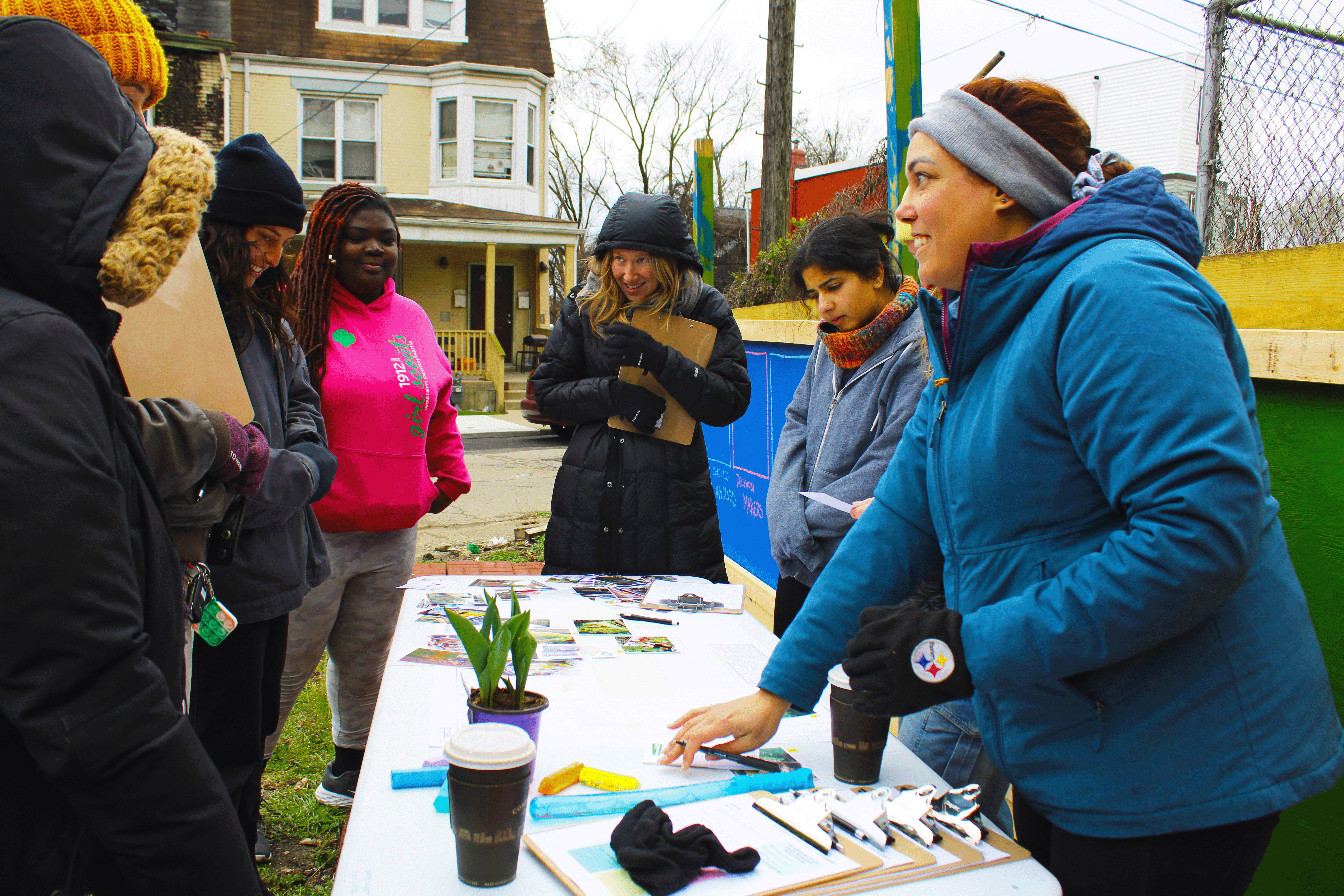Meet Zaheen. He’s Millvale’s Sustainability Coordinator, the author of our first ever Guest Blog Series, and all around awesome guy who knows his stuff when it comes to environmental and green neighborhood strategies. 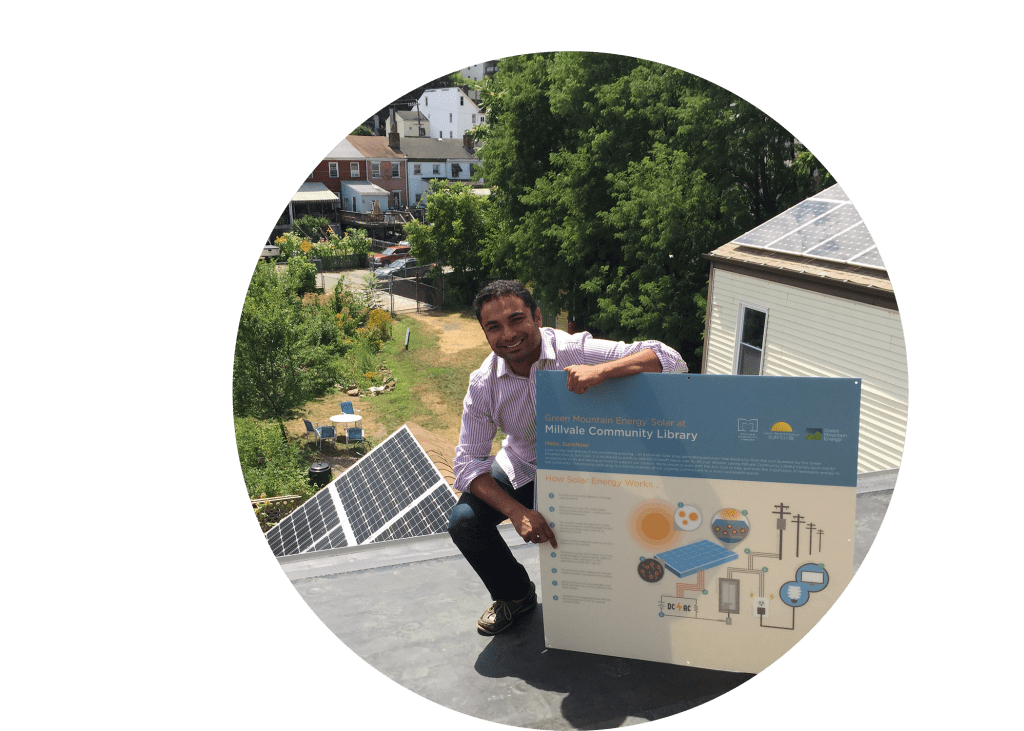
Zaheen’s work as a project manager at GTECH Strategies from 2012-2015, brought him to Millvale, where he was inspired by the positive things happening in the community. Zaheen has over four years of experience in working with neighborhoods all across Pittsburgh in resident leadership and community development projects. While in Millvale, Zaheen has helped steer the development of the Millvale EcoDistrict Pivot Plan 2.0, and also attended the National EcoDistrict Incubator.
This September, Zaheen attended the EcoDistrict Protocol Accredited Practitioner Training designed to help district teams understand and successfully navigate the EcoDistrict Certification Protocol. In this Guest Blog Series, Zaheen will share his knowledge and bring best practices from all over the country right here, to Pittsburgh. Even better, he and his partners will be hosting an EcoDistrict Micro-Incubator/Workshop, free to Neighborhood Allies focus neighborhoods, on Thursday, November 19th from 10:00am – 3:30pm.
EcoDistrict Summit Guest Blog
By: Zaheen Hussain | November 3, 2016
How Millvale’s EcoDistrict Came To Be
Armed with a community plan developed by utilizing the EcoDistrict Planning Process, residents and businesses worked together to create a vision for a more sustainable Millvale with programming in the areas of Food, Water, Energy, Air, Mobility, and Equity. Internal partnerships developed between the Borough of Millvale, the Millvale Community Development Corporation, the Millvale Community Library, New Sun Rising, amongst countless other residents and organizations lets us work together to help implement the community plan.
We also have strong partnerships with organizations all throughout the region who we have been able to work with to help move Millvale’s vision forward. This is a key strategy in being able to adopt best practices by not only learning from our residents and organizations internally, but also being able to learn from other communities.
One of these key partnerships for Millvale has been Neighborhood Allies. Neighborhood Allies has the mission of supporting the people, organizations and partnerships committed to creating and maintaining thriving neighborhoods. In 2014, as one of 6 Focus Neighborhoods (Pittsburgh Hilltop, Homewood, Larimer, Wilkinsburg, and the Hill District being the others), the Millvale Community Library was awarded a catalytic grant to fund a full-time librarian, and hire a Sustainability Coordinator as a shared community resource to help Millvale implement its EcoDistrict Plan.
Luckily, that Sustainability Coordinator turned out to be me! Sixteen months in, the mark Neighborhood Allies is leaving in Millvale is easy to see. The most simple measure is to look at the dollars invested, which certainly is a lot.
- 2014 Millvale Library & Sustainability Initiatives: $74,000
- 2015 Gardens of Millvale: $75,000
- 2016 Millvale EcoDistrict Collaborative Incubator Attendance: $10,000
- 2016 Love My Neighbor Grants (3): $3,500
- 2016 EcoDistrict National Summit Sponsorship: $500
That totals to $163,000 over the past two years. But it’s not that number that is the prize. The prize is what that investment has led to beyond the scope and timeline of those investments. The support from Neighborhood Allies paved the way for the recalibration of our EcoDistrict Plan. With strong headway being made in our original focus areas of Food, Water, and Energy, the community reconvened to also add Air Quality, Mobility, and Equity as additional focus areas in the EcoDistrict Plan.
This support has meant an increase in partnership development with organizations working on these issues, which makes it easier for resource-strapped communities like Millvale to accomplish our goals. In some instances, this support has helped us acquire funding for key studies and projects. This includes a funding partnership between the Library and the Heinz Endowments to create an air quality baseline as a foundation for strategic air quality planning. This also includes a funding partnership between the Library and the Henry L. Hillman Foundation to solarize the Millvale Community Center, develop a fellowship for Millvale teens to job-shadow solar installers, develop and implement a community needs assessment, and fund a Sustainability Coordinator to help implement these projects for another year (YES!). Best of all, these are just a couple of examples.
Part 1: 2016 EcoDistrict Summit
By: Zaheen Hussain | September 20, 2016
Millvale Sustainability Coordinator, Zaheen Hussain was in Denver last week, September 13th-15th at 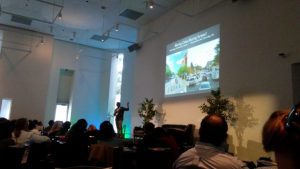 the EcoDistrict National Summit in Denver, Colorado. Zaheen, alongside Christine Mondor, and Anna Rosenblum of evoveEA, presented on bottom-up community engagement to transform a community, using the EcoDistrict planning process as a platform. The following blog series is a diary recount of Zaheen’s experience at the summit. The Millvale Sustainability Coordinator position is supported by the Millvale Community Library as a shared resource to forward the Millvale Community’s goals in sustainability.
the EcoDistrict National Summit in Denver, Colorado. Zaheen, alongside Christine Mondor, and Anna Rosenblum of evoveEA, presented on bottom-up community engagement to transform a community, using the EcoDistrict planning process as a platform. The following blog series is a diary recount of Zaheen’s experience at the summit. The Millvale Sustainability Coordinator position is supported by the Millvale Community Library as a shared resource to forward the Millvale Community’s goals in sustainability.
Hello from Denver, Colorado! Host city of the 2016 Ecodistrict Summit. For those who don’t know, Millvale has adopted the EcoDistrict Planning Process as its primary platform to implement sustainable community development projects through the year 2030. You can find our road map, known as the Millvale EcoDistrict Pivot 2.0 here!
The venue is cool, the presentations are engaging, and the speakers have all been fantastic and knowledgable. Through this week, I will be writing a blog highlighting our experiences here in Colorado as we continue to deepen our understanding around sustainable community redevelopment.
If I had to pick one word to define what day one has been about, it’s Equity. Equity has been at the tip of everyone’s tongue, a big component of nearly everyone’s presentation, and certainly a favorite component of Millvale’s EcoDistrict Plan, known as Pivot, among the Millvale crew.
So, what is equity? Equity to us represents fairness in the context of sustainable community redevelopment. Ensuring that as communities change, the beneficiaries aren’t limited to just those with resources, but are shared among all hard-working people. In lesser words, how do we work together to make sure people in the community are taken care of, have affordable housing, are connected to jobs, and positively impact the environment?
It’s often easy for everyone to get really excited about big flashy neighborhood redevelopment projects with all the bells and whistles of modern technology, modern landscaping and architecture, promoting every modern buzzword that can be thought of. One fundamental step many have either forgotten or not realized the importance of was actually thinking about whether or not these projects actually benefit who they are meant to benefit – the community.
Although we can lament about how we as a field (well, any field really) tend to lift up whatever buzzword is trendy in those years, it’s certainly refreshing to see that developers, and local leaders are working to get out front of the curve in addressing equity gaps in a way that almost seems too obvious.
What’s inspiring isn’t really any one project. In fact, I frankly can’t specifically recall them. It was more that the first thing people were talking about wasn’t the environment, or profit, but more importantly, how does planning positively impact a whole community of people first. It seems tied to a belief that if we take a systems approach to focus on people first, especially those who have been long committed to a community, that the environmental and economic benefits we desire will follow as a part of that system.
We heard from keynote speakers like Rohit Malotra, who was inspiring leaders to put more of an emphasis on building trust in a community, to Ryan Gravel, who helped us think more about how infrastructure can work to connect people to each other as well as to job opportunities. Gulgun Kayim showed us that art can instill pride and participation in a community, and Glenn Harris spoke on inclusivity being a key component of true community driven change with long term shared success.
Not only was it nice to be inspired by the leaders in the sustainability field from around the world, but great to know that the leaders within the Borough of Millvale, the Millvale Community Development Corporation, Millvale Community Library, and cross-community partners like New Sun Rising have the right idea too.
Equity also happens to be one of six programming areas in Millvale’s EcoDistrict Plan (Food, Water, Energy, Air, and Mobility being the others), within which we have the goal of Millvale being a “place of self-determination, where Millvalians are able to participate and shape their future as well as the future of others.”
So what does it all boil down to? For me, it’s participation. If we work hard to drive more resident participation in community meetings, local government, and volunteer opportunities, we will arrive at a truer reflection of community needs in order to work to address those needs. In order to drive participation, not only should we make the option of participation available, but make it truly accessible and inclusive. This starts with educating the community, but more importantly, it highlights the importance of actually listening to the community. Development can’t be for the benefit of just the developer, it also has to be to the benefit of the residents those developments should be striving to serve. As I work through the support of the Millvale Library to serve the entire community, I’m proud to say that the Millvale Library is a fantastic resource for residents to plug into all the great things happening in Millvale.
That’s all from Tuesday! We’re looking forward to our presentation on Wednesday. Hoping everyone is enjoying the lead-up to Millvale Days!
-Zaheen
Lunch for the day: Arepas from the Arepa Food Truck
Part 2: 2016 EcoDistrict Summit
By: Zaheen Hussain | September 21, 2016
Checking in from Denver, again! We kicked off the morning with our well attended presentation calledBottom Up Community Activation for District-Scale Success. I’ll get more into that later.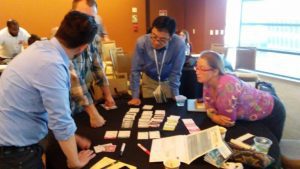
If the key word for day 1 was “equity,” day 2’s is probably “communication.” After our presentation, our day was made up of attending various workshops and presentations led by other national and local leaders who are also walking down the EcoDistrict path alongside Millvale.
Choosing what to go to was REALLY difficult, as many of the sessions sounded awesome. These includeHealthy Communities, Designed, A Just Transition to Clean Energy and Climate Resilience, and Finding a Common Language: Performance Metrics for Key Stakeholders. I ended up picking Water Infrastructure: Triumphs and Tears, as well as EcoDistricts Live and Learn/Try and Tell.
In the first session, we learned from experts across the nation on their experiences in developing water infrastructure. The big take-away here is that between engineering, regulatory compliance, community support, and ecological function, effective water infrastructure can have challenges and opportunities on many different levels. This means that for truly effective infrastructure to be built we have to have good communication channels and transparency between a lot of different sectors, partners, and stakeholders. If we work within ourselves, we may end up with a project or product that doesn’t make sense for all the people that may be impacted by it.
We certainly know that to be true here in Millvale (and much of Pittsburgh), where we have felt the impacts of outdated water management infrastructure, and live under the threat of future flooding. Many of the goals in our EcoDistrict plan over the next 15 years are around chipping away at reducing the threat of flooding and pollution by transforming not only how we use water, but also how it flows through our town. Studies have shown us that a majority of the water that flows through Girty’s Run is from beyond the borders of Millvale. That means that while we work to use water more efficiently in our homes & businesses, and build more green infrastructure like rain gardens and bioswales here in Millvale, we also have to be vigilant, and advocate for a more regional approach in transforming our water infrastructure to lessen the harmful impacts in places like Millvale and other downstream communities all over Western Pennsylvania (and the nation!).
In the last session of the day, EcoDistricts Live and Learn/Try and Tell, we heard from three different EcoDistricts in San Francisco! It was nice to hear from people who are working together on regional issues at the neighborhood scale, and connecting their work in order to be able to learn best practices from each other.
This brings me to why communication is my word of the day. All across the country, as we continue to trend towards wanting to live in urban centers, leaders everywhere are trying to figure out what is the best way to accommodate the influx of people, while not bringing harm to those who have called cities home all along. On top of that, we have to make sure that our cities are resilient in the face of an ever changing climate and other forms of environmental degradation. At the same time, as technology revolutionizes the way we look at, understand, and share information, people and organizations all across the board are trying to figure out how we can use it as a resource to better coordinate efforts. For example, if there are plans to repave a road by one authority, and upgrading sewer infrastructure under the road by another, it serves both authorities as well as tax-payers well to have the work be coordinated so that resources can be leveraged more efficiently. That coordination comes with communication. In Millvale, we are grateful to have leaders at the Borough level who are always looking to facilitate this kind of efficiency.
With advances in technology, a lot of what is happening in the community development and sustainability field are new to many people–from residents to businesses, to developers, to local leaders. That means that we will all have successes and failures. Whether it’s EcoDistricts, or another platform for sustainable neighborhood planning, it’s important to have a community of practice so that we can all lift each other up through mistakes and share in the joys of success. It makes me hope that as the years go on, that more Pittsburgh neighborhoods will choose EcoDistricts as a planning process. But most of all, it’s my hope that we are all communicative with each other, no matter what planning process is chosen, so that best practices can rise to the top. Additionally, the transparency that clear communication brings is the best way to build trust, support and participation among community members, especially if they see that there is a real attempt being made to be open and inclusive throughout the transformative process.
Back to our presentation! Anna, Christine, and I kicked off the day presenting in a session titled Bottom Up Community Activation for District Scale Success. In the session Anna and Christine dove into the EcoDistrict Protocol and the role of community members in planning and implementation. I had the opportunity of sharing as a case-study, the story of how Millvale is emerging as a leader in grassroots community driven neighborhood transformation. Participants then got to do a little brainstorming of their own, using flashcards developed by evolveEA to help communities determine EcoDistrict strategies that make sense for them. After all, strategies that work in one neighborhood might not make the most sense in another.
For folks in attendance, it wasn’t so much that the strategies were new or groundbreaking, because they weren’t. It was more about learning a new tool to utilize when engaging communities. It was really refreshing to see people taking inspiration from the hard work of Millvale residents and leaders as they daydreamed about their own!
That’s all for today! Look out for part three tomorrow!
-Zaheen
Lunch: Lentils, mixed veggies and injera (bread) from the Ethiopian Food Truck! Anna and Christine joined in on the goodness!
Part 3: 2016 EcoDistrict Summit
By: Zaheen Hussain | September 22, 2016
This is it! Last day of the EcoDistrict Summit in Denver. What’s the word of the day? Definitely “roadmap.” For the record, I didn’t plan on having words of the day, but hey, it worked out. 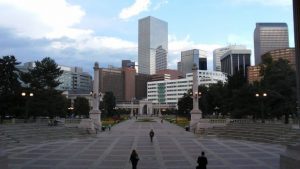
I spent the day at the EcoDistrict Accredited Practitioner Training with evolveEA’s own, Anna Rosenblum. It was an insightful afternoon, walking through the intricacies of what it takes to launch and then implement an EcoDistrict on several scales.
We heard from Eliot Allen of Criterion Planners who wrote the EcoDistrict Protocol Certification Handbook and Eric Corey Freed, who is the Chief Community Officer of at EcoDistricts headquarters back in Portland, OR.
They broke it down into three phases. Formation, Roadmapping, and Performance.
In the formation phase, organizations and interested residents (otherwise known as stakeholders) come together to build leadership, collaboration, and a decision-making process ahead of creating a long term initiative. This started to happen in Millvale way back in 2011 when a small group of leaders started to think about how we can help Millvale transition into the sustainable economy of the future. This includes creating a Declaration of Collaboration between key stakeholders and partners to create a common goal of moving forward.
In the roadmapping phase, all stakeholders work together to develop goals, objectives, performance measurements, and well, create a roadmap to implement their EcoDistrict. In Millvale, that has been known as the planning process, which led to the creation of the EcoDistrict Pivot Plan.
The performance phase is all about the cycle of implementation, measurement, calibration, and again, continued implementation. This is where the rubber meets the road. How does your roadmap stack up to reality? How are your goals being achieved? How are they being measured? Are you seeing the results you expected? If not, do your goals need to be adjusted, or are the results great in their own right? This might remind people close to Millvale’s process of our Pivot 2.0 process, where we celebrated goals that were accomplished in the areas of food, water, and energy, recalibrated some goals to better fit the reality on the ground and then added the new program areas of air, mobility, and equity.
At the training, we had the opportunity to look at a few different case studies along the way, all using the EcoDistrict process at different scales.
We looked at Capitol Hill in Seattle, which is a huge urban neighborhood I had the opportunity to visit this past spring. With over 32,000 people in their neighborhood, we saw how EcoDistricts as a process can work in a large scale in a functioning, long existing community looking to transition into a more sustainable community.
We also looked at the newly forming Sun Valley EcoDistrict in Denver. Sun Valley is also an existing neighborhood of 1,500 people, but also is adjacent to a brownfield (empty land where industry once used to be) that is ripe for transformation. Here we saw how EcoDistrict as a process can help existing communities with space to grow and create new assets.
And of course, we also looked at Millvale as a case study, which Anna and I had the opportunity to quickly present. Millvale was presented as a small community of 3,700 people with a lot of grassroots momentum that was generated through community education and outreach, leading to bootstrapped projects led by community members to make incremental changes as we work towards accomplishing long-term big picture goals in the 20 year scale. Mouthful – I know!
One of the biggest takeaways was that as a process, EcoDistricts can work on several different neighborhood scales, from economically active highly urban existing neighborhoods, to blank slate projects in spaces like former abandoned rail-yards.
Another take-away is that communities all across the country are both experts as well as novices in their own ways. Each scale has its own challenges and successes. In Millvale for example, although we are very resource strapped, we have a friendly community and local government to support innovation without the burden of overwhelming bureaucracy. In larger EcoDistricts, especially in big cities, the problems are reversed. They might be resource rich, but have to walk through a lot of red tape to implement their projects. What is important is finding what you’re good at, and running with it, while learning from others on what they are good at.
There was a good information to walk away with not only to help Millvale continue to make progress and one day become a certified Ecodistrict, but to help us think about how we can share our own institutional knowledge with surrounding communities to generate greater interest sustainable community development as a catalytic agent of change, not just in Millvale, but throughout the Pittsburgh region.
As was touched on yesterday, whether or not a community chooses EcoDistricts as a process, the greatest opportunity we have as a is to learn from each other. It’s easy to criticize transitioning communities nationally, as well as here in the Pittsburgh area for being unjust, or making mistakes — often rightfully. The truth though is that we are all entering uncharted waters in many ways, and when doing so, things will go wrong. The defining characteristic then becomes how we use the lessons we learn, both in our own community as well as from other communities to work towards more just and sustainable neighborhoods throughout the region. While community building requires a lot of focus on our own communities, it’s also important to build community amongst community builders (how many times can someone say community in one sentence?).
I feel very lucky to have attended this conference with the support of Neighborhood Allies and the Henry L. Hillman Foundation. To honor this investment in Millvale, we want to share how the EcoDistrict process has worked for us, and help other communities think through how it might work for them.
In Millvale, we have been very lucky to have had the chance to work really well in the neighborhood with partnerships between the Library, the Borough, the Development Corporation, and of course our residents. We have also been very lucky to have regional partners like New Sun Rising, evolveEA, Grow Pittsburgh, GTECH Strategies, Conservation Consultants, Neighorhood Allies and many more. The opportunity to share our experience with other communities, and find ways to learn from them as well is something we look forward to!
If you’re a community leader and are interested in learning more about an upcoming workshop on EcoDistricts this fall, please e-mail me at sustainable.millvale@gmail.com.
Thank you for following along in this experience!
-Zaheen
Lunch: Veggies and chickpea sandwich!
The views reflected in the blog are opinions of Zaheen Hussain as observed at the Summit. Many thanks to Neighborhood Allies and The Henry L. Hillman Foundation for supporting our attendance at the summit.

